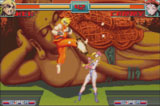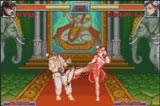 It’s blister time again! Capcom
recently released a portable version of a proven franchise. The game is Super Street
Fighter II Turbo Revival. Many might say it’s the same old thing again. This game
might appear that way on the surface, but when actually played you will realize there is
more to be found within. Mixing old school nostalgia with new features, Super Street
Fighter II Turbo Revival is a game that is a nice addition to the Game Boy Advance
library.
It’s blister time again! Capcom
recently released a portable version of a proven franchise. The game is Super Street
Fighter II Turbo Revival. Many might say it’s the same old thing again. This game
might appear that way on the surface, but when actually played you will realize there is
more to be found within. Mixing old school nostalgia with new features, Super Street
Fighter II Turbo Revival is a game that is a nice addition to the Game Boy Advance
library. Let’s
begin with the basic elements of the game, which is of course the arcade mode. You should
be familiar with this mode if you have ever played any of the other Street Fighter games;
it’s all about one-on-one fighting--human vs. the computer; it’s the age old
struggle of man versus machine. Not limiting the game to one option, Capcom has added
various other modes to play. There is a vs. mode just in case you want to lay a beating
down on a friend—assuming, of course, that he or she has a copy of the same game.
When playing the various modes you will be collecting vs. points along the way. These vs.
points unlock even more ways of playing the game, such as time attack and survival. These
other modes are essentially mini games that test your skills under a time limit. These
little extras give the game a level of replayability that should last you for a while.
Let’s
begin with the basic elements of the game, which is of course the arcade mode. You should
be familiar with this mode if you have ever played any of the other Street Fighter games;
it’s all about one-on-one fighting--human vs. the computer; it’s the age old
struggle of man versus machine. Not limiting the game to one option, Capcom has added
various other modes to play. There is a vs. mode just in case you want to lay a beating
down on a friend—assuming, of course, that he or she has a copy of the same game.
When playing the various modes you will be collecting vs. points along the way. These vs.
points unlock even more ways of playing the game, such as time attack and survival. These
other modes are essentially mini games that test your skills under a time limit. These
little extras give the game a level of replayability that should last you for a while.
 Super Street
Fighter II Turbo Revival displays a graphical quality that is impressive to behold. Every
thing the eye can see (with the help of good lighting) is filled with vibrant colors and
smooth edges. The background has the same animations that we all know well. In keeping
with the turbo part of the title, Capcom has added four speeds the game can be played at.
There is the normal, which is of course a pace anyone can play at, but there are also
three turbo settings. At each level the gameplay is sped up, but generally not at the
expense of the frame rate. There are times in the turbo 3 setting, however, when too much
action on the screen at one time causes a bit of slow down.
Super Street
Fighter II Turbo Revival displays a graphical quality that is impressive to behold. Every
thing the eye can see (with the help of good lighting) is filled with vibrant colors and
smooth edges. The background has the same animations that we all know well. In keeping
with the turbo part of the title, Capcom has added four speeds the game can be played at.
There is the normal, which is of course a pace anyone can play at, but there are also
three turbo settings. At each level the gameplay is sped up, but generally not at the
expense of the frame rate. There are times in the turbo 3 setting, however, when too much
action on the screen at one time causes a bit of slow down.
 When Street
Fighter was at its peak of popularity, anyone who played the game could recognize Ryu
performing his fireball move by audio clues alone. That sound is back, along with all the
other battle cries of the other combatants. The music when selecting characters is all
there too. Everything that you remember hearing from previous installments is back and
adds to the whole nostalgic experience. However, I recommend using headphones to eliminate
some of the distortion emitted from the speaker.
When Street
Fighter was at its peak of popularity, anyone who played the game could recognize Ryu
performing his fireball move by audio clues alone. That sound is back, along with all the
other battle cries of the other combatants. The music when selecting characters is all
there too. Everything that you remember hearing from previous installments is back and
adds to the whole nostalgic experience. However, I recommend using headphones to eliminate
some of the distortion emitted from the speaker.
 On the down
side, It is games like this that make me wish that the Game Boy Advance had two more
buttons. By lacking two buttons, gameplay is hindered. Knowing this, Capcom tried to make
accommodations by providing two options. The first allows you to tap either A or B for a
light attack; press and hold the same button for a medium attack, and the shoulder buttons
are the heavy attacks. The other option has the A and B button as the light attack, the
shoulder buttons are the medium attack, and by pressing A+L or B+R delivers a heavy
attack. Even though both options are available, performing combos become a challenge that
many will not accept. Another issue surrounds the d-pad being so small. This lack of size
increases the difficulty of performing moves that require circular motions. In this way,
the game suffers from hardware limitations rather than programming.
On the down
side, It is games like this that make me wish that the Game Boy Advance had two more
buttons. By lacking two buttons, gameplay is hindered. Knowing this, Capcom tried to make
accommodations by providing two options. The first allows you to tap either A or B for a
light attack; press and hold the same button for a medium attack, and the shoulder buttons
are the heavy attacks. The other option has the A and B button as the light attack, the
shoulder buttons are the medium attack, and by pressing A+L or B+R delivers a heavy
attack. Even though both options are available, performing combos become a challenge that
many will not accept. Another issue surrounds the d-pad being so small. This lack of size
increases the difficulty of performing moves that require circular motions. In this way,
the game suffers from hardware limitations rather than programming.
 Capcom has
proven again that 2d fighters are not dead yet. They have successfully mixed old school
fighting and multiple modes of play into one solid package. Despite the few problems, fans
of the series should enjoy taking this wherever they go--once they become familiar with
the controls. For those of you, who have not played the series before, this is a good one
to start with.
Capcom has
proven again that 2d fighters are not dead yet. They have successfully mixed old school
fighting and multiple modes of play into one solid package. Despite the few problems, fans
of the series should enjoy taking this wherever they go--once they become familiar with
the controls. For those of you, who have not played the series before, this is a good one
to start with.
